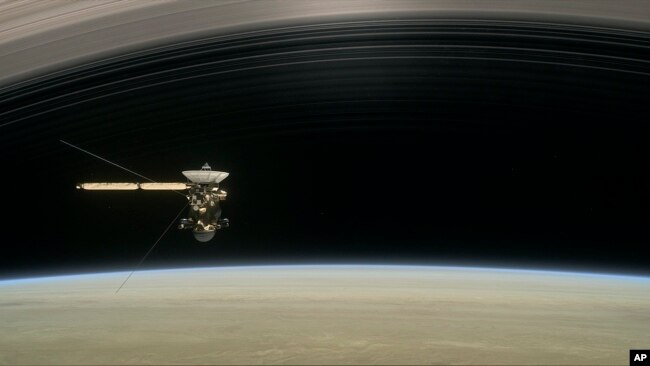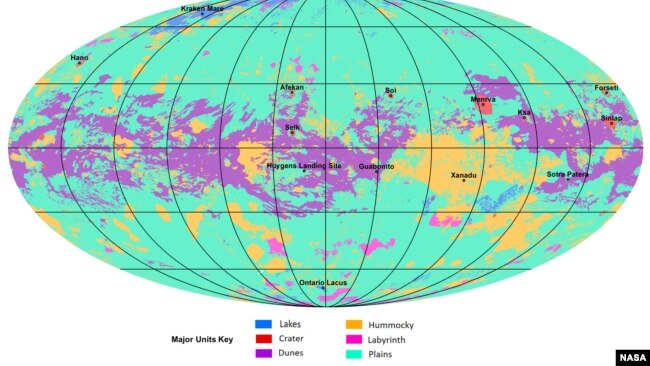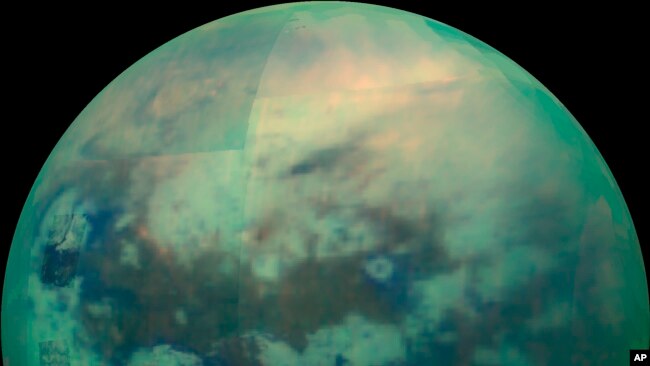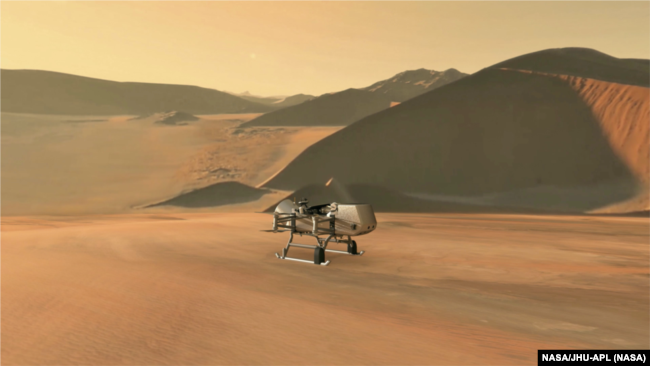The data was collected by Cassini, a spacecraft operated by the U.S. space agency NASA. The spacecraft studied Saturn and its moons from 2004 to 2017. Astronomers used images and radar measurements from Cassini to create the geological map of Titan.
The map shows Titan as a mixture of flat plains, hills and mountains, windblown sand areas, valleys and lakes. The mapping operation is described in a report published in Nature Astronomy.
Rosaly Lopes led the project. She is a planetary scientist at NASA’s Jet Propulsion Laboratory in Pasadena, California. Lopes told the publication that the many similarities between Earth and Titan make the Saturn moon a great choice for continued exploration.
“Titan has an atmosphere like Earth. It has wind, it has rain, it has mountains,” Lopes said. “It’s a really very interesting world, and one of the best places in the solar system to look for life.”
 |
| This image made available by NASA in April 2017 shows a still from the short film "Cassini's Grand Finale," with the spacecraft diving between Saturn and the planet's innermost ring. (NASA/JPL-Caltech via AP) |
Titan is the only planet in our solar system besides Earth to have known bodies of liquid on its surface. But Titan’s seas and lakes are filled with liquid methane rather than water. Methane, a gas, behaves as a liquid on Titan because the planet is extremely cold.
At cold temperatures, methane goes through similar changes as rain on Earth. It falls to the surface across the planet to form rivers and lakes and can then evaporate to form clouds again.
The map found that nearly two-thirds of Titan’s surface is made up of flat plains, Nature reported. About 17 percent is covered in sandy hills shaped by the wind, mostly around the equator.
 |
| The first global geologic map of Saturn's largest moon, Titan, is based on radar and visible and infrared images from NASA's Cassini mission, which orbited Saturn from 2004 to 2017. In the annotated figure, the map is labeled with several of the named sur |
Unlike Earth, Titan’s sand is made up of carbon, hydrogen, nitrogen and oxygen. Around 14 percent of the surface is considered hilly or mountainous.
Seas and lakes filled with liquid methane cover an estimated 1.5 percent of Titan. The liquid exists mainly closer to the planet’s poles, while the equatorial areas remain drier.
Ralph Lorenz is a planetary scientist at the Johns Hopkins University Applied Physics Laboratory in Laurel, Maryland. He told the publication one of Cassini’s most interesting discoveries “is that Titan is so diverse.” Lorenz added: “It’s almost like a completely different world, and this systematic mapping marshals that diversity.”
 |
| This Nov. 13, 2015 composite image made available by NASA shows an infrared view of Saturn's moon, Titan, as seen by the Cassini spacecraft. The near-infrared wavelengths in this image allow the cameras to penetrate the haze and reveal the moon's surface. |
Rosaly Lopes says organic materials – those containing carbon - in Titan’s atmosphere are important for the growth of living organisms. “Organics are very important for the possibility of life on Titan, which many of us think likely would have evolved in the liquid water ocean under Titan’s icy crust,” she said.
Scientists believe the mixing of organic material and liquid could have caused complex molecules to develop, or possibly life itself.
 |
| Artist illustration of Dragonfly on Titan, one of Saturn's moons. |
The search for possible life on Titan will continue when NASA launches its Dragonfly mission to explore the planet in 2026. Dragonfly is a drone, or pilotless aircraft. It is designed to capture images from above Titan as well as to land on the planet to collect data.
Dragonfly is not expected to arrive at Titan until 2034. But when it does, Lopes and her team will be excitedly awaiting its findings. “It is not only scientifically important but also really cool - a drone flying around on Titan,” she said. “It will be really exciting.”
Bryan Lynn.
Bryan Lynn wrote this story for VOA Learning English, based on reports from Nature Astronomy, NASA, Reuters and Agence France-Presse. Caty Weaver was the editor.
Source News
We want to hear from you. Write to us in the Comments section, and visit our Facebook page.
No comments:
Post a Comment
Note: Only a member of this blog may post a comment.